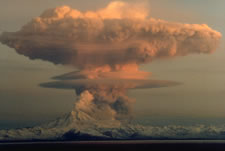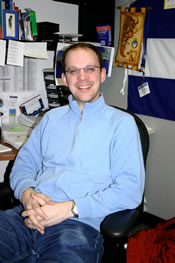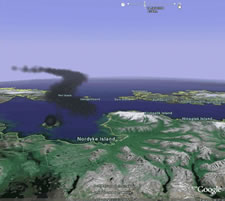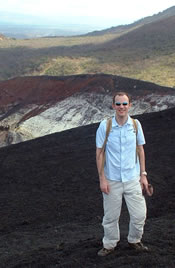Augustine eruption leads to updated model

Photo by R. Clucas
A massive eruption cloud ascended from Redoubt volcano on April 21, 1990. The mushroom-shaped plume spread upward from avalanches of hot debris--pyroclastic flows--that cascaded down the north flank of the volcano. A smaller, white steam plume rose from the summit crater.
By Lorien Nettleton, Arctic Region Supercomputing Center
January 2007
Peter Webley knew Alaska was an ideal place to study volcanoes. However, he didn't expect to be dealing with the first stages of a full-blown eruption within 72 hours of his arrival in Fairbanks.
British-born Webley was in town only three days when Mount Augustine in Alaska's Cook Inlet started rumbling to life after a 10-year slumber. What began as a puffy plume of steam rising from deep within the earth catastrophically changed Jan. 11, 2006 into a column of volcanic ash spewing 45,000 feet into the air. The dramatic event had the potential to change the lives of thousands of Alaskans on the ground and countless international airline passengers in the skies flying over the North Pole en route to points all over the globe.

Photo by Leone Thierman, ARSC
Peter Webley is a postdoctoral fellow for the Arctic Region Supercomputing Center and the UAF Geophysical Institute/Alaska Volcano Observatory.
"I was thrown into it straight away," Webley said. "I'd never been involved in an eruption firsthand. I'd been at observatories around the world, but here I was, 24/7 and saying, 'Wow, this is how an eruption works!' I certainly learned a lot and very quickly," he said.
A postdoctoral fellow with the Arctic Region Supercomputing Center and the Geophysical Institute at the University of Alaska Fairbanks, Webley came to UAF from a research position at King's College in London. His mission is to update and extend "Puff," a computer model developed at UAF which tracks and predicts ash cloud movement.
UAF researchers and scientists use satellite data, along with land-based observations and modeled predictions of ash-cloud movements, to track and monitor Alaska's volcanoes. These information sources make it possible to provide critical health and safety information to emergency responders, policy makers and residents of the Pacific Northwest.
"That was the attraction of working at UAF--I could be involved in the research and the operational side of my work right in my own backyard," he said.
Ash clouds pose a significant health risk because they can raise the presence of airborne particulate matter to unhealthy and dangerous levels. Even more serious is the danger ash clouds pose to jet aircraft. While ash clouds look the same as normal clouds--particularly to pilots--the tiny, razor-sharp volcanic particles can cause an immediate shutdown if enough ash is sucked into an engine.
That very thing happened during the December 1989 eruption of Alaska's Mount Redoubt. A KLM Royal Dutch Airlines Boeing 747 with 231 passengers aboard flew into an ash cloud at 27,900 feet and all four engines quit. The plane began a terrifying freefall, dropping more than two miles before the captain was able to restart the engines and safely land in Anchorage.
More than 150 potentially active volcanoes are located in the North Pacific region. The 70 or so in Alaska are constantly monitored by satellite and/or land-based instruments . With the large number of volcanoes within easy volcanic ash cloud range of Ted Stevens Anchorage International Airport, the highest-volume air cargo handler in the nation, technology to issue ash cloud forecasts is an indispensable part of mitigating potential damage to commerce and property, not only in Alaska, but also throughout the Pacific Ring of Fire.
Risk management for natural disasters like volcano eruptions is critical to the transportation and cargo industries so they can provide safe, timely and profitable business transactions in Alaska. The estimated costs of the 1989 Redoubt eruption totaled $160 million, making it one of the most expensive in U.S. history.
Puff was initially developed as a method for simulating ash cloud trajectories during the 1989 Redoubt eruption. Various models of tracking and predicting ash cloud movements were developed starting in the 1990s under the direction of Ken Dean, co-group leader of the Earth and Planetary Remote Sensing Group at UAF's Geophysical Institute. The Puff computer program is the grandchild of all this work, Webley said.
"I was still adjusting to living in the states, filling out forms and trying to get settled," said Webley, of Dec. 12, 2005--three days after his arrival in Fairbanks--when the Augustine eruption began and he was asked to run simulations of the ash cloud's possible path. The simulations were used by the Alaska Volcano Observatory, a joint program of UAF's Geophysical Institute, the U.S. Geological Survey and the state of Alaska Division of Geological and Geophysical Surveys to help formulate warnings. Puff is used in conjunction with the National Weather Service for air traffic warnings and to provide health advisories for the surrounding Cook Inlet area.
The high-speed computational resources of the Arctic Region Supercomputing Center are helping Webley develop more accurate models. A new Puff computer model will provide faster and more accurate forecasts of ash cloud behavior, which will help keep damage to a minimum if Augustine or Redoubt decide to blow their tops again.
For more information please contact:
- Peter Webley, postdoctoral fellow, ARSC, pwwebley@alaska.edu, 907-474-1542
- Ken Dean, research professor, Geophysical Institute, ken.dean@gi.alaska.edu, 907-474-7364
- Lorien Nettleton, science writer/web developer, ARSC, nettlto@arsc.edu, 907-450-8628
- Debra Damron, communications group leader, ARSC, damron@arsc.edu, 907-450-8662
Other useful links:
- Arctic Region Supercomputing Center
- Alaska Volcano Observatory
- Puff Volcanic Ash Tracking Model
- Earth and Planetary Remote Sensing Group
- U.S. Geological Survey
- State of Alaska Division of Geological and Geophysical Surveys
- Real-Time Satellite Thermal Monitoring of Central American Volcanoes
- Google Earth
- USGS article about dangers presented by ash clouds







